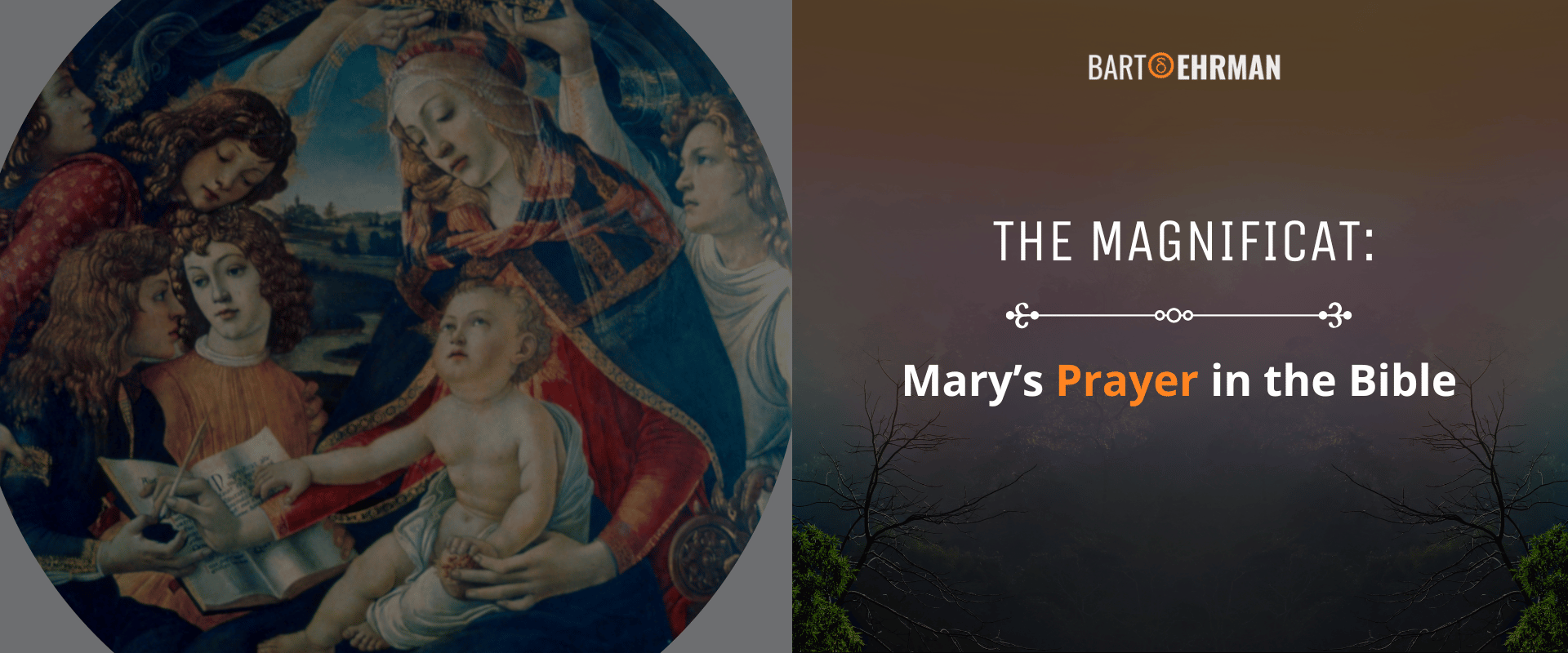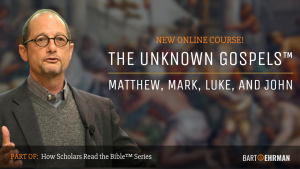The Magnificat: Mary’s Prayer in the Bible

Written by Marko Marina, Ph.D.
Author | Historian
Author | Historian | BE Contributor
Verified! See our guidelines
Verified! See our editorial guidelines
Date written: October 2nd, 2024
Edited by Laura Robinson, Ph.D.
Disclaimer: The views and opinions expressed in this article belong to the author and do not necessarily match my own. - Dr. Bart D. Ehrman
In the Christian tradition, prayer has always held a central place, shaping not only personal devotion but also the very fabric of the faith itself. From the earliest days of the new religion, prayer was seen as a powerful force, guiding the hearts and minds of believers.
Take St. Augustine, for instance — one of Christianity's greatest thinkers — who famously argued that the practice of prayer revealed a deeper truth about the necessity of God's grace. According to Augustine, Christians pray not just for daily needs but for a transformation of their will, asking God to instill a greater love for him and their neighbors.
This close relationship between prayer and belief is captured by the ancient phrase “lex orandi, lex credendi” (“the rule for how you pray is the rule for what you believe”). In other words, how Christians pray reflects the core of what they believe. One of the most profound prayers in the New Testament is the Magnificat — a prayer that, according to Luke’s Gospel, Mary, the mother of Jesus, spoke.
Often referred to as the “Magnificat Prayer,” this hymn of praise emerges from an intensely personal moment in Mary’s life, yet its words had a paramount significance in the later development of the Christian tradition.
But what makes the Magnificat truly extraordinary? Why has this prayer, allegedly spoken by a young woman in ancient Judea, resonated so deeply with believers across the ages?
In this article, we’ll explore the historical context of Mary’s Magnificat, examine its significance within the Gospel of Luke, and uncover the rich layers of meaning that continue to make Mary’s prayer one of the most enduring and powerful voices in Christian Scripture.
If you’re interested in diving deeper into the Gospels and uncovering the historical context behind their accounts, Dr. Bart D. Ehrman’s online course, “The Unknown Gospels: Matthew, Mark, Luke, and John”, is a must-see.
Consisting of eight captivating lectures, Dr. Ehrman addresses key questions: Can we corroborate the accounts of the Gospels? Are they historically reliable, or are some of them based on myth and legend? These essential inquiries lie at the heart of his course thus offering a scholarly exploration of the New Testament documents.

The Magnificat Prayer: Basic Information
The Magnificat appears in the Gospel of Luke, specifically in Luke 1:46-55. What does Magnificat mean? The term comes from the Latin word for “magnifies” or “glorifies,” which is the opening word of Mary’s prayer in the Latin Vulgate translation: “Magnificat anima mea Dominum” (“My soul magnifies the Lord”).
It is one of the most celebrated hymns of the New Testament, spoken by Mary after she visits her cousin Elizabeth. The prayer occurs at a pivotal moment in Luke’s Gospel, where the narrative shifts to emphasize God’s favor for the lowly and marginalized.
The Gospel of Luke itself was written approximately 50 to 60 years after the death of Jesus, during a time when early Christian communities were establishing their identities. While traditionally attributed to Luke, a companion of Paul, modern scholarship understands the Gospel as the work of an anonymous Christian author.
Moreover, this writer drew from a range of earlier sources — both written accounts and oral traditions — to craft a narrative that addressed the specific social and theological needs of his community.
We discuss the authorship of the Gospel of Luke, as well as the social context in which it was written, in more detail in separate articles for those who wish to explore these topics further.
The Magnificat’s narrative setting centers on a deeply personal and emotional moment: Mary’s visit to her cousin Elizabeth. At this point in Luke’s narrative, Mary has recently learned from the angel Gabriel that she will give birth to Jesus, the Son of God.
In response to this astounding news, she sets out to visit Elizabeth, who is herself miraculously pregnant with John the Baptist. This encounter between the two women is charged with joy and divine affirmation.
As soon as Mary arrives and greets Elizabeth, the baby in Elizabeth’s womb leaps, and she is filled with the Holy Spirit, proclaiming Mary blessed among women. It’s precisely at this point in Luke’s narrative that Mary, overwhelmed with divine presence, utters the prayer.
Now that we’ve explored the narrative background of the Magnificat, it's time to take a look at the prayer itself. Don’t worry, we’ve got you covered — no need to go searching through your Bible apps or rifling through the pages!
We’re about to serve up the Magnificat in its full New International Version glory. Aren’t we amazing? Here’s Mary’s prayer as recorded in Luke 1:46-55:
My soul glorifies the Lord and my spirit rejoices in God my Savior, for he has been mindful of the humble state of his servant. From now on all generations will call me blessed, for the Mighty One has done great things for me — holy is his name. His mercy extends to those who fear him, from generation to generation. He has performed mighty deeds with his arm; he has scattered those who are proud in their inmost thoughts. He has brought down rulers from their thrones but has lifted up the humble. He has filled the hungry with good things but has sent the rich away empty. He has helped his servant Israel, remembering to be merciful to Abraham and his descendants forever, just as he promised our ancestors.
And with that, we have Mary’s heartfelt declaration of faith and God's justice. Now let’s dive deeper into the historical and rhetorical meaning of Mary’s Magnificat.
FREE COURSE!
WHY I AM NOT A CHRISTIAN
Raw, honest, and enlightening. Bart's story of why he deconverted from the Christian faith.
Over 6,000 enrolled!
The Magnificat: Critical Interpretation
The origin of the Magnificat has long been a subject of debate among scholars, with many critical voices rejecting the traditional claim that Mary herself is the source of this hymn. While it might sound compelling in certain circles to attribute such a profound prayer to the young mother of Jesus, most scholars contend that this view doesn’t hold up under critical scrutiny.
As Joseph A. Fitzmyer notes in his Commentary on Luke, the Magnificat prayer likely comes from a pre-Lukan (Jewish or Christian) tradition, not from Mary’s direct testimony. (Affiliate Disclaimer: We may earn commissions on products you purchase through this page at no additional cost to you. Thank you for supporting our site!)
Moreover, the hymn’s heavy reliance on the Greek Old Testament (Septuagint) and its resemblance to other Jewish hymns, such as the Song of Hannah in 1 Samuel, suggest it was part of a broader liturgical or hymnic tradition that Luke incorporated into his Gospel.
So, while the idea of Mary penning this beautiful prayer might be heartwarming, it’s not the view the majority of scholars embrace.
Did You Know?
Mary: The Queen of Heaven... and of Croats!
The Assumption of Mary, celebrated by Catholics on August 15th, is one of the most important Marian dogmas. According to Catholic teaching, at the end of her earthly life, Mary was taken up body and soul into heaven — an event known as the Assumption.
This belief underscores her unique role in salvation history and highlights her significance in Catholic tradition as the Mother of God. Defined as official dogma by Pope Pius XII in 1950, the Assumption emphasizes Mary's special place not only in heaven but also in the hearts of Catholics worldwide.
Now, speaking of Mary’s importance, here in Croatia, we take our devotion to the next level! Known affectionately as “Kraljica Hrvata” (“The Queen of Croats”), Mary holds a particularly special place in the hearts of Croatians.
In fact, there’s a famous song, “Rajska Djevo, Kraljice Hrvata” (“Heavenly Maiden, Queen of Croats”), that’s a must-play at almost every wedding ceremony. No celebration is complete without it. After all, if you’re going to declare your undying love, why not have Mary, Queen of Croats, as your witness?
Michael Wolter, in his analysis, also supports this scholarly consensus and emphasizes that the Magnificat is most likely a pre-Lukan composition. He notes that the hymn functions within the Gospel not as a personal reflection of Mary’s inner thoughts, but as a theological declaration of God’s action in the world.
The Magnificat, Wolter argues, reflects Luke’s broader theological program, which emphasizes the great reversals of social status and divine intervention.
By placing this hymn in Mary’s mouth, Luke connects the message of the Gospel — God’s favor for the lowly and marginalized — with the broader narrative of Jesus’ mission. So, while the hymn fits neatly into the Gospel’s structure, its origins lie in the liturgical traditions of early Christian communities.
The Magnificat has two main parts and a conclusion. The first part (Luke 1:46-50) focuses on God’s attributes — might, holiness, and mercy — while the second part (Luke 1:51-53) emphasizes God’s great deeds, particularly the reversal of societal structures.
God scatters the proud, dethrones the powerful, and lifts the lowly. As Fitzmyer notes, these themes of social reversal are central to the Magnificat prayer and reflect the eschatological vision of God’s kingdom that runs throughout Luke’s Gospel.
Finally, the hymn’s conclusion (Luke 1:54-55) ties this divine action to the covenant promises made to Israel and connects God’s intervention in Mary’s life to his faithfulness toward his people.
In his Commentary on Luke, Joel B. Green reveals another important aspect of the Magnificat prayer: God’s decisive actions. He notes that the verbs are consistently in the aorist tense (which ancient Greeks used to indicate a completed action), underscoring God’s already decisive intervention in the world.
Green links this to the narrative context and interprets the “Magnificat” as a declaration that God’s eschatological work has already been set in motion.
What makes the Magnificat particularly fascinating is how it reflects both personal and communal salvation. On the one hand, Mary celebrates God’s favor toward her — she, a humble servant, is chosen to bear the Messiah.
On the other hand, the hymn broadens its scope to include God’s transformative work for all of Israel, especially the lowly and oppressed. This dual focus on personal and collective salvation, as Wolter highlights, showcases the theological depth of the Magnificat, where Mary’s individual experience mirrors God’s universal plan for salvation.
In essence, the Magnificat prayer isn’t merely a personal song of gratitude but a bold theological proclamation. It declares God’s mighty acts of justice and mercy, affirming His commitment to the poor and marginalized.
As Fitzmyer and Wolter both show, this hymn reveals Luke’s skill in weaving together personal narratives with broader theological themes, thus offering readers a glimpse into the eschatological hope that lies at the heart of the Gospel.

Conclusion
The Magnificat stands as a significant text within the Gospel of Luke, not only for its literary and theological content but also for its reflection of the historical and cultural contexts in which it emerged.
This hymn, drawing heavily on Old Testament themes and language, illustrates how early Christian communities incorporated Jewish liturgical traditions to articulate their emerging theological concerns. That, of course, shouldn’t surprise us! Both Jesus and his early followers came from a Jewish background.
Structurally, the Magnificat reinforces key themes in Luke’s Gospel, such as social reversal, divine justice, and God’s faithfulness to Israel. The emphasis on God’s intervention in favor of the lowly and oppressed mirrors broader apocalyptic expectations prevalent in early Christian communities.
Finally, St. Augustine’s famous principle “lex orandi, lex credendi” — that prayer reflects belief —
offers a useful lens through which to understand the Magnificat’s role in shaping early Christian identity. The prayer reflects not only the personal piety of early Christians but also their collective vision of a transformed social order, grounded in divine action.
In this sense, the Magnificat prayer is both a product of its time and a reflection of the broader religious and cultural dynamics that shaped the early Christian movement.

